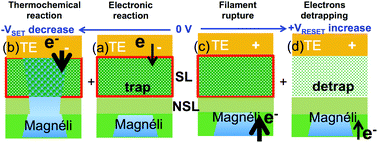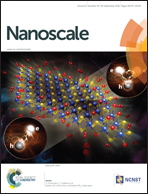A study of the transition between the non-polar and bipolar resistance switching mechanisms in the TiN/TiO2/Al memory
Abstract
Thermochemical and electronic trapping/detrapping mechanism-based resistance switching in TiO2 is one of the most extensively researched topics in the field of resistance-switching random access memory (ReRAM). In this study, the subtle correlation between the formation and rupture of the Magnéli-based conducting filament (CF), which is the mechanism of non-polar thermochemical-reaction-based switching, and the electron trapping/detrapping at the defect centers, which is the mechanism of bipolar electronic switching, is examined in detail. The chemical interaction between the TiN top electrode and the TiO2 layer generates a stable and immobile electron trapping layer, which is called a “switching layer”, whereas the thin region between the just-mentioned switching layer and the remaining Magnéli CF after the thermochemical reset comprises a non-switching layer. The seemingly very complicated switching behavior with respect to the bias polarity, compliance current, and detailed biasing sequence could be reasonably explained by the phenomenological model based on the combined motions of the CF, switching layer, and non-switching layer. Light-induced detrapping experiments further supplement the suggested switching model.


 Please wait while we load your content...
Please wait while we load your content...